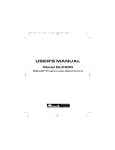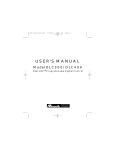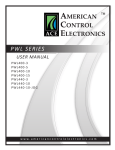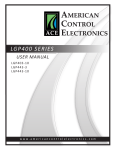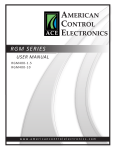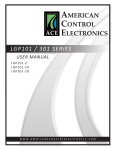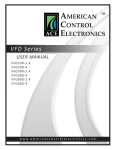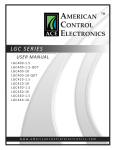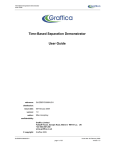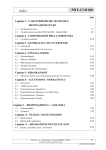Download CLD Series - American Control Electronics
Transcript
C L D S eries USER MANUAL CLD 100- 1 www.americancontrolelectronics.com Dear Valued Consumer: Congratulations on your purchase of the CLD100 Series display. This User Manual was created for you to get the most out of your new device and assist with the initial setup. Please visit www.americancontrolelectronics.com to learn more about our other drives. Thank you for choosing American Control Electronics! © 2014 American Control Electronics. All rights reserved. No part of this document may be reproduced or transmitted in any form without written permission from American Control Electronics. The information and technical data in this document are subject to change without notice. American Control Electronics makes no warranty of any kind with respect to this material, including, but not limited to, the implied warranties of its merchantability and fitness for a given purpose. American Control Electronics assumes no responsibility for any errors that may appear in this document and makes no commitment to update or to keep current the information in this document. CLD Series Safety First! SAFETY WARNINGS ! WARNING! Text in gray boxes denote important safety tips or warnings. Please read these instructions carefully before performing any of the procedures contained in this manual. • DO NOT INSTALL, REMOVE, OR REWIRE THIS EQUIPMENT WITH POWER APPLIED. Have a qualified electrical technician install, adjust and service this equipment. Follow the National Electrical Code and all other applicable electrical and safety codes, including the provisions of the Occupational Safety and Health Act (OSHA), when installing equipment. • Reduce the chance of an electrical fire, shock, or explosion by using proper grounding techniques, over-current protection, thermal protection, and enclosure. Follow sound maintenance procedures. ! WARNING! It is possible for a drive to run at full speed as a result of a component failure. American Control Electronics strongly recommends the installation of a master switch in the main power input to stop the drive in an emergency. Circuit potentials are at 115 VAC or 230 VAC above earth ground. Avoid direct contact with the printed circuit board or with circuit elements to prevent the risk of serious injury or fatality. Use a non-metallic screwdriver for adjusting the calibration trim pots. Use approved personal protective equipment and insulated tools if working on this drive with power applied. i CLD Series Table of Contents Section 1. Introduction........................................................ 1 Section 2. Specifications...................................................... 2 Section 3. Dimensions.. ........................................................ 3 Section 4. Installation. . ........................................................ 4 Mounting...................................................................................... 4 Panel Mounting............................................................................. 5 Wiring........................................................................................... 7 Shielding Guidelines.............................................................. 8 Connections.................................................................................. 9 Line Voltage Terminals (G, L1, L2)........................................... 9 Output Terminals (S1, S2). . ..................................................... 9 Feedback Terminals (+, IN, C)................................................10 Inhibit Terminal (INH)...........................................................10 Frequency Terminal (Fin). . .....................................................10 Section 5. Operation. . ........................................................ 12 Feedback Device Selection............................................................12 Select Switches.............................................................................13 Line Voltage Switch (SW501).................................................13 Encoder Power Supply Voltage (SW502, DIP Switch 1)............14 Feedback Device Selection (SW502, DIP Switches 2 & 3).........15 Reference Signal Selection (SW502, DIP Switches 4 & 5).........16 Section 6. Calibration........................................................ 17 MIN and MAX...............................................................................18 Section 7. Programming..................................................... 19 Calculating Parameters.. ................................................................19 Speed Scaling Factor.............................................................19 Load Response Number. . .......................................................20 Display Scaling Factor.. ..........................................................20 Gate Time . . ...........................................................................21 Decimal Point Location Number . . ...........................................21 Entering the Programming Mode...................................................22 Viewing the Programming Screens.................................................22 ii CLD Series Entering Calculated Program Parameters.......................................23 Save the Program Settings and Exit the Programming Mode . . ..........23 Set the Speed...............................................................................24 Programming Examples.................................................................25 Section 8. Leader-Follower Applications.............................. 31 Leader-Follower Example Using A Leader Encoder..........................33 Leader-Follower Example Using Two CLD100’s................................35 Section 9. Troubleshooting. . ............................................... 39 Unconditional Warranty.. .................................................... 41 iii CLD Series List of Figures Figure Figure Figure Figure Figure Figure Figure Figure Figure Figure Figure Figure iv 1 2 3 4 5 6 7 8 9 10 11 12 CLD100 Dimensions. . .......................................................... 3 Panel Cutout...................................................................... 5 Inserting the CLD1600........................................................ 5 Inserting the Brackets........................................................ 6 Secure the CLD100............................................................. 6 CLD100 Connections.. ........................................................11 SW501 - Line Voltage Switch. . ............................................13 SW502, DIP Switch 1 - Encoder Power Supply Voltage.........14 SW502, DIP Switches 2 and 3 - Feedback Device Selection..15 SW502, DIP Switches 4 and 5 - Reference Signal Selection..16 Leader-Follower Connections with a Leader Encoder..........34 Leader-Follower Connections with Two CLD100s.. ...............38 CLD Series Section 1. Introduction The CLD100 Series control is a dual-voltage digital control used with a drive, motor, and feedback device to regulate and display motor speed. The user may enter and display the motor speed in RPM or other units, such as feet per minute or inches per second. The CLD100 offers the advantage of repeatable speed settings and speed stability. Basic operation principles The CLD100 generates a frequency and compares this to the frequency coming from the feedback transducer attached to the motor shaft. The CLD100 then generates an analog voltage to the speed control to corect for any difference between the the CLD100 reference frequency and the motor feedback frequency. The CLD100 also counts the motor transducer pulses for a fixed period of time (called gate time) and displays this value on the front panel, usually in the form of motor revolutions per minute. The CLD100-generated frequency is derived from an internal 50 Hz refrence. The generated frequency is equal to the 50 Hz internal reference multiplied by the set speed. The product of the internal reference and set speed is then divided by the speed scale factor (SSF), which is entered by the user via the front pushbuttons. Refer to page 19 for more information on setting the speed scale factor. 1 CLD Series Section 2. Specifications AC Line Voltage AC Power Acceptable Feedback Sources 115/230 VAC ± 10%, 50/60 Hz, 1Ø 5.5 watts nominally 5 VDC or 12 VDC NPN-type encoder 5 VDC or 12 VDC NPN-type proximity switch Hall effect sensor Magnetic pickup Feedback Frequency Range External Reference Frequency* 10 - 3000 Hz External Input Frequency Range** 0 - 500 kHz Analog Output Voltage Range Standard Gate Time Power Supply Voltage for Feedback Devices Speed Regulation Feedback Frequency Range Ambient Operating Temperature Range Weight 0 - 10 VDC 1 second 5 VDC or 12 VDC (10 mA max) 0.05% of set speed 0 - 3000 Hz 50 - 1040F / 10 - 400C appoximately 1 lb * +5 VDC CMOS logic level signal or open-collector NPN transistor; applied to IN and C terminals ** Signal applied to Fin and C terminals. The product of the CLD leader frequency and speed setting may not exceed 500 kHz. 2 CLD Series Section 3. Dimensions 3.75 [95] 2.13 [54] E 0.25 [6] 4.53 [115] 0.85 [22] 3.38 [86] 1.73 [44] ALL DIMENSIONS IN INCHES [MILLIMETERS] Figure 1. CLD100 Dimensions 3 CLD Series Section 4. Installation ! WARNING! Do not install, rewire, or remove this control with input power applied. Failure to heed this warning may result in fire, explosion, or serious injury. Make sure you read and understand the Safety Precautions on page i before attempting to install this product. Variable speed drives manufactured by other companies may require hookup procedures that differ from those given in this manual. Contact your local American Control Electronics distributor for assistance. Mounting • Protect the control from dirt, moisture, and accidental contact. • Provide sufficient room for access to the terminal block and calibration trim pots. • Mount the control away from heat sources. Operate the drive within the specified ambient operating temperature range. • Prevent loose connections by avoiding excessive vibration of the drive. 4 CLD Series Panel Mounting Step 1. Cut a rectangular hole in the panel 1.78 inches (45 mm) and 3.38 inches (86 mm) wide. PANEL 3.38 [86] 1.78 [45] CUTOUT AREA BOUNDED BY DASHED LINES Figure 2. Panel Cutout Step 2. Slide the CLD100 into the panel opening. Figure 3. Inserting the CLD100 5 CLD Series Step 3. Insert the two mounting brackets into each side of the CLD100 case. E Figure 4. Inserting the Brackets Step 4. Secure the CLD100 to the panel using the bracket screws. Figure 5. Secure the CLD100 6 CLD Series Wiring ! WARNING! Do not install, rewire, or remove this control with input power applied. Failure to heed this warning may result in fire, explosion, or serious injury. Circuit potentials are at 115 or 230 VAC above ground. To prevent the risk of injury or fatality, avoid direct contact with the printed circuit board or with circuit elements. Do not disconnect any of the motor leads from the drive unless power is removed or the drive is disabled. Opening any one motor lead while the drive is running may destroy the drive. This product does not have internal solid state motor overload protection. It does not contain speed-sensitive overload protection, thermal memory retention or provisions to receive and act upon signal from remote devices for over temperature protection. If motor over protection is needed in the end-use product, it needs to be provided by additional equipment in accordance with NEC standards. • Use 18 - 24 AWG wire for logic wiring. Use 14 - 16 AWG wire for AC line and motor wiring. 7 CLD Series Shielding Guidelines ! WARNING! Under no circumstances should power and logic level leads be bundled together. Induced voltage can cause unpredictable behavior in any electronic device, including motor controls. As a general rule, American Control Electronics recommends shielding of all conductors. If it is not practical to shield power conductors, it is recommended to shield all logic-level leads. If shielding of all logic-level leads is not practical, the user should twist all logic leads with themselves to minimize induced noise. It may be necessary to earth ground the shielded cable. If noise is produced by devices other than the drive, ground the shield at the drive end. If noise is generated by a device on the drive, ground the shield at the end away from the drive. Do not ground both ends of the shield. If the drive continues to pick up noise after grounding the shield, it may be necessary to add AC line filtering devices, or to mount the drive in a less noisy environment. Logic wires from other input devices, such as motion controllers and PLL velocity controllers, must be separated from power lines in the same manner as the logic I/O on this drive. 8 CLD Series Connections ! WARNING! Connections to regenerative drives and ACE PWP series drives differ from connections to non-regenerative drives. Improper connection to regenerative or PWP series drives may result in damage to the CLD100 or drive. Variable speed drives manufactured by other companies may require hookup procedures that differ from those given in this manual. Contact your local American Control Electronics distributor for assistance. Line Voltage Terminals (G, L1, L2) Connect the line voltage to these terminals. The CLD100 is ON when power is applied to these terminals. Always provide a positive disconnect to shut down the CLD100 in case of an emergency. Do NOT apply power to the CLD100 until selector switch SW501 has been properly set. See page 13 for details. Output Terminals (S1, S2) If using a non-regenerative drive, connect the CLD100 S1 to drive S1 and the CLD100 S2 to drive S2. Refer to Figure 6 on page 11. If using a regenerative drive, connect the CLD100 S1 to drive S0 and the CLD100 S2 to drive S2. Refer to Figure 6 on page 11. If using a PWP series drive, connect the CLD100 S1 to drive S2 and the CLD100 S2 to drive S1. Refer to Figure 6 on page 11. 9 CLD Series Feedback Terminals (+, IN, C) If using a magnetic pickup, connect the pickup signal lead to terminal IN and the signal common to terminal C. If an optical encoder is used, connect its positive input voltage lead to +, the signal lead to IN, and the signal common to terminal C. The voltage on the + terminals is determined by DIP switch 1. Only one feedback source may be used at a time. Refer to Figure 6 on page 11. Inhibit Terminal (INH) Short terminal INH to common (C) to inhibit the CLD100. The CLD100 output will drop to the MIN trim pot setting. Remove the short to resume operation. Refer to Figure 6 on page 11. Frequency Terminal (Fin) The CLD100 can be used as a signal source to control another CLD100 via SO502 terminals FO+ and FO-. SO502 is a two-terminal, cage-clamp terminal block onthe printed circuit board. The frequency output available from these terminals is equal to 50% fo the commanded speed. Refer to page 31 for instructions on a leader-follower configuration. The leader CLD may only control one follower CLD. If you are not using the leader-follower configuration, make no connections to Fin, FO+, and FO-. 10 CLD Series MODEL CLD100-1 INPUT 115/230V AC, 50/60 Hz, 50 mA AMERICAN CONTROL ELECTRONICS, SOUTH BELOIT, IL 61080 www.americancontrolelectronics.com G L1 L2 S1 S2 Fin + IN C INH NON-REGENERATIVE DRIVE S1 REGENERATIVE DRIVE S0 PWP DRIVE S2 S2 S2 S1 SIGNAL COMMON AC VOLTAGE +5 VDC or +12 VDC EARTH GND FROM CCW TERMINAL 115 VAC or 230 VAC FROM WIPER TERMINAL INHIBIT SWITCH OPEN TO RUN CLOSE TO INHIBIT MAGNETIC PICKUP (NON-POLARIZED) OPTICAL ENCODER Figure 6. CLD100 Connections 11 CLD Series Section 5. Operation Feedback Device Selection Acceptable feedback frequency at any set speed in an application must lie within the 0 - 3000 Hz range. Feedback frequency is directly proportional to the number of feedback pulses per revolution (PPR) and to the speed of the shaft (RPM) that the feedback transducer monitors. The feedback range relates to the motor speed as follows: PPRminimum = 600 PPRmaximum = RPMminimum 120,000 RPMmaximum EXAMPLE 1: Consider an application in which the feedback source is monitoring a driven shaft, and not the motor armature shaft. This shaft is running at speeds as low as 1 RPM. PPRminimum = 600 RPMminimum = 600 1 = 600 The selected feedback device must produce at least 600 PPR. EXAMPLE 2. Consider an application the requires monitoring and controlling a driven shaft at speeds as high as 4000 RPM. 120,000 120,000 PPRmaximum = = = 30 RPMmaximum 4000 The selected feedback device must produce 30 or fewer PPR. The CLD100 can control armature shaft speeds within a 30:1 speed range. Under no circumstances can the CLD100 be expected to control motor speed beyond this speed range. 12 CLD Series C501 Y501 J501 C506 Select Switches IC503 IC501 Line Voltage Switch (SW501) C502 C504 IC502 C505 Access the switches from the rear of the CLD100 case. Using a screwdriver, loosen the two screws that attach the nameplate to the case. The switches are visible when the nameplate is removed. 1 IC504 SO502 T501 C503 The slide switch on the left rear of the CLD100 (Figure 7) is the voltage switch. Set this switch to the left position for 115 VAC input or to the right for 230 VAC input. FO+ FO- INT EXT +12 SO501 LINE VOLTAGE SWITCH SW502 P502 MAG 115 - 230 MAX OPTO SW501 MIN P501 Figure 7. SW501 - Line Voltage Switch 13 CLD Series Encoder Power Supply Voltage (SW502, DIP Switch 1) DIP switch 1 selects the supply voltage for an external encoder (Figure 8). Set to OFF for +5 VDC source or to ON for a +12 VDC source. If using a device that does not need to be powered by the CLD100, set to OFF. OPTO MAG EXT INT OPTO MAG EXT INT SW502 +12 +12 VDC ENCODER SUPPLY VOLTAGE ON +12 +5 VDC ENCODER SUPPLY VOLTAGE SW502 The power supply voltage has a maximum current of 10 mA. ON Figure 8. SW502, DIP Switch 1 - Encoder Power Supply Voltage 14 CLD Series Feedback Device Selection (SW502, DIP Switches 2 & 3) MAG EXT INT MAG EXT INT SW502 +12 OPTO +12 ON OPTO OPTICAL ENCODER FEEDBACK SW502 DIP switches 2 and 3 are for feedback device selection (Figure 9). If using an optical pickup, hall sensor, proximity switch, or an open-collector transducer, set DIP switch 2 to ON and 3 to OFF. If a magnetic pickup is used, set DIP switch 2 to OFF and 3 to ON. MAGNETIC PICKUP FEEDBACK ON Figure 9. SW502, DIP Switches 2 and 3 - Feedback Device Selection 15 CLD Series Reference Signal Selection (SW502, DIP Switches 4 & 5) OPTO MAG EXT INT OPTO MAG EXT INT SW502 +12 EXTERNAL REFERENCE SIGNAL ON +12 INTERNAL REFERENCE SIGNAL SW502 DIP switches 4 and 5 are for reference signal selection (Figure 10). If an internal reference signal is used (normal operation), set DIP switch 4 to OFF and 5 to ON. If an external reference signal is used, set DIP switch 4 to ON and 5 to OFF. The external reference is only used in LeaderFollower applications. ON Figure 10. SW502, DIP Switches 4 and 5 - Reference Signal Selection 16 CLD Series Section 5. Calibration ! WARNING! Dangerous voltages exist on the CLD100 when it is powered. When possible, disconnect the voltage input from the CLD100 before adjusting the trim pots. If the trim pots must be adjusted with power applied, use insulated tools and the appropriate personal protection equipment. BE ALERT. High voltages can cause serious or fatal injury. All adjustments increase with CW rotation, and decrease with CCW rotation. Use a non-metallic screwdriver for calibration. Each trim pot is identified on the printed circuit board. Calibrate the drive for use with the CLD100. The purpose is to optimize the response on the drive to the CLD100 signal and to minimize any tendency by the drive to independently attempt to regulate motor speed. The following are the drive’s trim pot settings: Minimum Speed: CCW (motor stopped) Maximum Speed: CW (maximum voltage setting) Acceleration: CCW (fastest acceleration) Deceleration: CCW (fastest deceleration) IR Compensation: CCW (minimum regulation) Current Limit: 150% of motor current rating. 17 CLD Series MIN and MAX 1. Set the MIN and MAX trim pots full CCW. 2. Set the motor speed to zero using the following steps. A. Press ENTER once. The most significant digit (the leftmost numeral) will blink. B. Use the UP and DOWN pushbuttons to set this digit to zero. C. Press ENTER once. The second digit from the left will blink. D. Use the UP and DOWN pushbuttons to set this digit to zero. E. Press ENTER once. The third digit from the left will blink. F. Use the UP and DOWN pushbuttons to set this digit to zero. G. Press ENTER once. The least significant digit (the rightmost numeral) will blink. H. Use the UP and DOWN pushbuttons to set this digit to zero. I. Press ENTER once to return to operating mode. 3. Adjust the MIN trim pot CW until the motor shaft starts to rotate. Slowly adjust the MIN trim pot CCW until the motor just stops. 4. Set the CLD100 speed to 200% of maximum desired motor speed as outlined in step 2 above. 5. Adjust the MAX trim pot until the motor is running at 120% of desired motor speed. 6. Check that the MIN trim pot does not need to be readjusted after completing this procedure by repeatings steps 2 and 3 as necessary. 18 CLD Series Section 7. Programming Calculating Parameters Five parameters must be known before programming the CLD100. These parameters are speed scaling factor, load response, display scaling factor, gate time, and decimal point location. All parameters must be programmed into the CLD100 except for the gate time. Speed Scaling Factor The speed scaling factor (SSF) correlates the digital speed set at the CLD100 with the speed (in RPM) desired at the feedback shaft. The SSF equation is SSF = (Speed Entry)(3000) (Shaft RPM)(PPR) where, Speed Entry = speed programmed into the CLD100. This speed entry may be numerically different than the actual shaft RPM (for example, feet per minute, gallons per minute, inches per second, etc.) Shaft RPM = the speed (in RPM) of the shaft where the feedback device is mounted. = the number of pulses per revolution generated by the PPR feedback device. The SSF range is 3 through 9999 and the factory setting is 50. 19 CLD Series Load Response Number The load response number determines how fast the CLD100 responds to load changes. The higher the load response number, the faster the CLD100 will respond. The load response number range is 0 through 99. The factory setting is 25. Display Scaling Factor The display scaling factor (SSF) correlates the speed displayed by the CLD100 with the speed at the feedback shaft. The DSF equation is SSF = (Speed Display)(3000) (Shaft RPM)(PPR) where, Speed Display = speed displayed by the CLD100. This speed entry may be numerically different than the actual shaft RPM (for example, feet per minute, gallons per minute, inches per second, etc.) = the speed (in RPM) of the shaft where the feedback Shaft RPM device is mounted. = the number of pulses per revolution generated by the PPR feedback device. The DSF range is 3 through 9999 and the factory setting is 50. 20 CLD Series Gate Time The display scaling factor determines the gate time (the time between successive display updates). The recommended gate time range is 0.5 3 seconds. The gate time equation is shown below: Gate Time = DSF 25 Decimal Point Location The decimal point location number fixes the decimal point within the CLD100 display. The CLD100 may be set for no decimal point, or for a decimal point in the tenths, hundredths, or thousandths position. The factory setting is for no decimal point. 21 CLD Series Entering the Programming Mode 1. Press and hold the ENTER pushbutton (labeled E) while applying AC power to the CLD100 only. Do not apply power to the drive. 2. Release the ENTER pushbutton after AC power is applied. You have entered the programming mode when the decimal point appears on the display in the lower right-hand corner. If no decimal points appear or if any number is flashing, remove AC power and repeat steps 1 and 2. Viewing the Programming Screens The programming screens are identified by the position of the decimal point displayed; one decimal indicates speed scaling factor mode, two decimals indicates load response number mode, three decimals indicates display scaling factor mode, and four decimals indicate decimal point location. The CLD100 factory settings are: 22 Speed Scaling Factor = 50 Display: 0 0 5 0. Load Response = 25 Display: 0 0 2.5. Display Scaling Factor = 50 Display: 0 0.5.0. Decimal Point Location = None Display: 0.0.0.0. CLD Series Entering the Calculated Program Parameters 1. Press ENTER until the decimal point is displayed in the lower right corner (e.g. 1 2 3 4.). 2. Press the UP and DOWN pushbuttons until you reach the desired speed scaling factor. 3. Press ENTER until their are two decimal points displayed (e.g. 1 2 3.4.). 4. Press the UP and DOWN pushbuttons until you reach the desired load response number. 5. Press ENTER until their are three decimal points displayed (e.g. 1 2.3.4.) 6. Press the UP and DOWN pushbuttons until you reach the desired display scaling factor. 7. Press ENTER until their are four decimal points displayed (e.g. 1.2.3.4.). 8. Press the UP and DOWN pushbuttons until the desired decimal location is displayed. 0.000 = no decimal (e.g. 1 2 3 4) 0.001 = tenths (e.g. 1 2 3.4) 0.002 = hundredths (e.g. 1 2 .3 4) 0.003 = thousandths (e.g. 1.2 3 4) Save the Program Settings and Exit the Programming Mode 1. Press and hold the ENTER pushbutton. 2. Press the UP pushbutton to exit the program mode. Repeat steps 1 and 2 if you are still in the programming mode. If a numeral is flashing, press ENTER repeatedly until all digits stop flashing. 23 CLD Series Set the Speed 1. Press ENTER once. The most significant digit will blink. 2. Use the UP and DOWN pushbuttons to set the desired value for this digit. 3. Press ENTER once. The second digit from the left will blink. 4. Use the UP and DOWN pushbuttons to set the desired value for this digit. 5. Press ENTER once. The third digit from the left will blink. 6. Use the UP and DOWN pushbuttons to set the desired value for this digit. 7. Press ENTER once The least significant digit will blink. 8. Use the UP and DOWN pushbuttons to set the desired value for this digit. 9. Press ENTER once to return to the operating mode. 10. Remove power to the CLD100. 11. Reconnect the drive and apply power to the CLD100 and drive simultaneously. 12. The motor will accelerate to the set speed. 13. To change the set speed, repeat steps 1 - 9. 24 CLD Series Programming Examples Example 1 An application uses a 30 tooth magnetic pickup mounted on a motor shaft. The application requires that the motor speed and display be equal to the speed entry. Calculate the program parameters. Solution: PPR = 30 (given in example) Shaft RPM = 100 (arbitrarily chosen) Speed Entry = 100 (same as Shaft RPM) Speed Display = 100 (same as Shaft RPM) SSF = (Speed Entry)(3000) (100)(3000) = = 100 (Shaft RPM)(PPR) (100)(30) DSF = (Speed Display)(3000) (100)(3000) = = 100 (Shaft RPM)(PPR) (100)(30) Gate Time = DSF 100 = = 2 seconds 50 50 25 CLD Series Example 2 An application uses a 60 tooth magnetic pickup mounted on a motor shaft. The application requires that the motor speed and display be equal to the speed entry. Calculate the program parameters. Solution: PPR = 60 (given in example) Shaft RPM = 100 (arbitrarily chosen) Speed Entry = 100 (same as Shaft RPM) Speed Display = 100 (same as Shaft RPM) SSF = (Speed Entry)(3000) (100)(3000) = = 50 (Shaft RPM)(PPR) (100)(60) DSF = (Speed Display)(3000) (100)(3000) = = 50 (Shaft RPM)(PPR) (100)(60) Gate Time = DSF 50 = = 1 second 50 50 The PPR in this example is larger than the PPR in Example 1. Increasing the PPR decreases the speed scaling factor, display scaling factor, and the game time. 26 CLD Series Example 3 An application uses a 30 tooth magnetic pickup mounted on a motor shaft that is part of an exercise treadmill. The pulley is driving a belt that has a radius of 4 inches. The applications requires the user to enter the speed in miles per hour, and the display to read in miles per hour. Calculate the program parameters. Solution: PPR = 30 (given in example) Speed Entry = 10 (for 10 miles per hour, arbitrarily chosen) Speed Display = 10 (same as Speed Entry) Shaft RPM = Need to calulate by converting 10 miles per hour into RPMs. NOTE: Circumference of pulley = 2π * radius = 2π * 4 inches 10 miles = 10 miles x 5280 feet x 12 inches x 1 revolution x 1 hour = 1 mile 1 foot 2π*(4) inches 60 minutes hour 1 hour 420.17 revolutions = 420.17 RPM minute SSF = (Speed Entry)(3000) (10)(3000) = = 2.379 ≈ 2 (Shaft RPM)(PPR) (420.17)(30) DSF = (Speed Display)(3000) (10)(3000) = = 2.379 ≈ 2 (Shaft RPM)(PPR) (420.17)(30) Gate Time = DSF 2 = = 0.04 seconds 50 50 The gate time is too small. You may introduce a decimal point on the display. 27 CLD Series The user could enter 100 which would appear as 10.0 miles per hour the display. The speed entry and speed display numbers in the formula now become 100. Recalculating parameters. SSF = (Speed Entry)(3000) (100)(3000) = = 23.79 ≈ 24 (Shaft RPM)(PPR) (420.17)(30) DSF = (Speed Display)(3000) (100)(3000) = = 23.79 ≈ 24 (Shaft RPM)(PPR) (420.17)(30) Gate Time = DSF 24 = = 0.48 seconds ≈ 0.5 seconds 50 50 Adding a decimal point widens the input range (the range of settings from 0 to maximum), increases the gate time, and decreases the rounding error to the nearest digit in the first calculation of the SSF and DSF. The CLD100 has a gate time range of 0.5 - 3 seconds. 28 CLD Series Example 4 An application uses a 30 tooth magnetic pickup mounted on the high speed shaft of a gear motor. The gear ratio is 40:1 and the high speed RPM is 1800. The user will enter the speed of the geared shaft. The gear shaft RPM is what will be displayed as well. Solution: PPR = 30 (given in example) Speed Entry = 10 (for 10 RPM, arbitrarily chosen) Speed Display = 10 (same as Speed Entry) Shaft RPM = Speed of high speed shaft. If geared shafting is running at 10 RPMs (Speed Entry), then high speed shaft is running at 400 RPMs (10 x 40:1 Gear Ratio). SSF = (Speed Entry)(3000) (10)(3000) = = 2.5 ≈ 3 (Shaft RPM)(PPR) (400)(30) DSF = (Speed Display)(3000) (10)(3000) = = 2.5 ≈ 3 (Shaft RPM)(PPR) (400)(30) Gate Time = DSF 2.5 = 50 50 = 0.05 seconds The gate time is not within the CLD100’s range of 0.5 - 3 seconds. There is alos a significant error (20%) in rounding 2.5 to 3. Introduce a decimal point and recalculate the program parameters. Since the user will enter 10.0 for 10 RPM, the speed entry is now 100. The speed display is also 100. 29 CLD Series Recalculating the program parameters: SSF = (Speed Entry)(3000) (100)(3000) = = 25 (Shaft RPM)(PPR) (400)(30) DSF = (Speed Display)(3000) (100)(3000) = = 25 (Shaft RPM)(PPR) (400)(30) Gate Time = DSF 50 = 25 50 = 0.5 seconds This is much more acceptable. Note that there is no error due to rounding here because the SSF and DSF came out to be whole numbers. 30 CLD Series Section 8. Leader-Follower Applications The CLD100 can be used to follow an external frequency for leaderfollower applications. The external frequency must be a 5 VDC CMOS logic-level signal or an open-collector NPN transistor. The external frequency must be within the range of 10 - 3000 Hz for correct operation. The product of the external frequency and the set speed on the CLD100 must not exceed 500 kHz. This will limit the speed set value to to 5000 or less (500,000 / 10 = 50,000; however, the CLD100 only uses 4 digits. Thus, the maximum is 5000). The display can be set to read the speed ratio, actual speed in RPM, or a process value (such as feet per second or gallons per minute). Values of 100 and 1000 have the advantage of being easily read as a ratio or percentage of the leader. To select external reference, set DIP switch 4 of SW502 to ON and DIP switch 5 to OFF. Refer to Figure 10 on page 16. 31 CLD Series Leader-Follower Example Using A Leader Encoder In this example, the CLD100 recieves a signal from an encoder on a lead motor. The CLD100 then controls a follower motor at 100% of the lead motor’s speed. Assume the following conditions exist: - The lead motor’s maximum speed is 1800 RPM. - The resolution of the encoder on the lead motor is 60 lines. - The magnetic pickup on the follower motor has 30 teeth. NOTE: For this example, if the set speed is 100, the motor will follow at 100% of the lead motor’s speed. If the set speed is 50, the motor will follow at 50% of the lead motor’s speed. The CLD100 will display the follower speed in RPM. Step 1. Calculate the leader frequency (FR) using the following formula: FR = Maximum RPM of lead motor * PPR of lead feedback 60 Thus, FR = 1800 * 60 = 1800 Hz. 60 Step 2. Calculate the follower frequency (FM) using the following formula: FM = Maximum RPM of follower motor * PPR of follower feedback 60 Thus, FM = 32 1800 * 30 = 900 Hz. 60 Having derived FR and FM, you can now calculate the speed scale factor. CLD Series Step 3. Calculate the SSF Program the speed scale factor (SSF) per the following formula: SSF = FR * Set Speed FM where, = FR calculated in step 1. FR = FM calculated in step 2. FM Set Speed = Desired leader/follower speed ratio, expressed as a percentage. For example, if you want the follower to run at half the speed of the leader, the set speed is 50. For this example, the set speed is 100 (i.e. match the leader speed). Thus, SSF = FR * Set Speed = FM 1800 * 100 900 = 200 The speed scale factor is 200. 33 CLD Series MODEL CLD100-1 INPUT 115/230V AC, 50/60 Hz, 50 mA AMERICAN CONTROL ELECTRONICS, SOUTH BELOIT, IL 61080 www.americancontrolelectronics.com G L1 L2 S1 S2 Fin + IN C INH NON-REGENERATIVE DRIVE S1 REGENERATIVE DRIVE S0 PWP DRIVE S2 S2 S2 S1 MAGNETIC PICKUP (NON-POLARIZED) COMMON +5 VDC OR +12 VDC AC LINE VOLTAGE SIGNAL EARTH GND FROM WIPER TERMINAL 115 VAC or 230 VAC FROM CCW TERMINAL RUN-STOP SWITCH OPEN TO RUN CLOSE TO STOP FOLLOWER MOTOR LEADER SHAFT 0 - 1800 RPM OPTICAL ENCODER Figure 11. Leader-Follower Connections with a Leader Encoder 34 CLD Series Leader-Follower Example Using Two CLD100’s ! The CLD100 may drive only one follower using this method. WARNING! In this example, the follower CLD100 recieves a signal from a leader CLD100. The follower CLD100 then controls a follower motor at 100% of the lead motor’s speed. Leader-Follower Connections Use 14 - 28 AWG wire to connect the leader and follower CLD100’s. Connect SO502 terminal FO- on the leader CLD100 to the C terminal on the follower CLD100. Connect SO502 terminal FO+ on the leader CLD100 to the Fin terminal on the follower CLD100. Refer to Figure 12 on page 38. If the leads are longer than 12 inches (30 cm), it is recommended ot use shielded leads. If shielding is not practical, twist all logic leads with themselves to minimize induced noise. Programming the Leader Program the leader CLD100 to reflect the following conditions. Refer to page 19 for instructions on programming a CLD100. 1. Set the speed scale factor (SSF) to 100. Although the SSF may be set to any value, the frequency output via FO+ and FO- is always the equivalent of 50% of set speed. Thus, setting the SSF to 100 makes it easier to monitor the signal sent to the follower CLD100. 2. Set the display scale factor (DSF) to 100. Like the SSF, the DSF may be set to any value; however, a setting of 100 makes it easier to monitor the system. 35 CLD Series Programming the Follower Program the follower CLD100 as follows; 1. Calculate the follower reference frequency (FR) using the following formula: FR = 25 * Lead Motor Speed in RPM SSF of Lead CLD100 In this example, assume the lead motor speed is 1800 RPM. The leader SSF in this example is 100. Thus, FR = 25 * Lead Motor Speed in RPM 25 * 1800 = = 450 Hz SSF of Lead CLD100 100 2. Calculate the follower motor feedback frequency (FM) using the following formula: FM = In this example, assume the lead motor speed is 1800 RPM. The leader SSF in this example is 100. Thus, FM = Follower Motor Speed in RPM * PPR of Follower Feedback 60 As noted earlier, assume the motor speed is 1800 RPM. The follower feedback is 30 PPR in this example. Thus, FM = 36 1800 * 30 = 900 Hz 60 CLD Series 3. Calculate the speed scale factor SSF using the following formula: SSF = FR * Follower Speed as a % of Leader Speed FM Using the FR from step 1, the FM from step 2, and using a set speed of 100% for this example... SSF = 450 * 100 = 50 900 The speed scale factor is 50. Enter this value as the SSF on the follower CLD100. 4. It is recommended that you set the DSF of the follower CLD100 to 100. Although any you can set whatever DSF value you’d like, setting it to 100 removes the need to correlate the DSF value with system speed. 5. Enter the follower speed setting as a percentage of the lead motor speed. For example, if you want the follower to run at the same speed as the leader, the speed setting would be 100. To run the follower at half the leader speed, enter 50, or 33 to run at 33%, etc. Refer to page 24 for instructions on entering the set speed. 37 CLD Series MOTOR DRIVE NO. 1 MOTOR DRIVE NO. 2 MOTOR MOTOR 30T 30T LINE INPUT PICK-UP P501 MAX OUT MIN OUT C IN H 1 2 3 4 5 SW501 T501 G L1 L2 S1 S2 IN T EXT MA G OPT O +12 Fin + IN P502 Fin + IN 115- 230 SW502 FO + FO– P501 SW501 P502 MAX OUT MIN OUT T501 1 C IN H IN T EXT MA G OPT O +12 G L1 L2 S1 S2 115- 230 PICK-UP 1 2 3 4 5 SW502 FO+ FO – 1 C502 + C503 + C502 + C503 IC501 + IC501 IC502 + IC502 + C504 C504 C501 C506 C505 IC503 C501 C506 C505 Y50 1 IC503 Y501 RUN RUN E STOP STOP E LEADER (RPM) FOLLOWER NO. 1 SET IN PERCENT/DISPLAY IN RPM 1800 SET SPEED = 1800 RPM SSF = 100 DSF = 100 FREQ (FR) = 450 HZ FREQ (M) = 900 HZ 100 SET SPEED = 1800 RPM SSF = 50 DSF = 100 FREQ (FR) = 450 HZ FREQ (M) = 900 HZ Figure 12. Leader-Follower Connections with two CLD100s 38 CLD Series Section 9. Troubleshooting The motor will not run. 1. The connections from the CLD100 ot the drive, or the drive to the motor, may not be wired correctly. Check the connections from the CLD100 to the drive and from the drive to the motor. 2. The drive may be defective. Disconnect the CLD100 from the drive. Connect a speed adjust potentiometer to the drive and see if the drive runs the motor properly. 3. The motor may be defective. Test the system with another motor. The motor will not lock into speed. 1. The load response number may be too low (if the oscillation is gradual) or too high (if the oscillation is rapid). 2. The drive may be incorrectly calibrated. Check that the acceleration, deceleration, and IR Comp trim pots are at their minimum settings. 3. If a magnetic pickup is used, extensive runout may cause an interruption in the feedback pulse train. Check that the pickup’s sensing tip is directly over the center of the gear teeth. The gap between the sensing tip and the gear tip should be no greater than 0.010 inches. 4. Electrical noise may cause the CLD100 to attempt corrections that are not justified. Check the continuity and shielding of the pickup leads. 5. Rapid shifts in load may be pulling the motor out of its set speed. Consider using a regenerative drive with the CLD100. 39 CLD Series The motor is running at a fixed difference below set speed. 1. There may be a 60 Hz signal riding on the pickup leads. Check that the pickup leads are run in their own conduit and that all connections are secure. For long paths, these leads must be shielded, and properly grounded at the CLD100 end. The motor is running at a fixed difference below set speed. 1. There may be an electromechanical defect in the pickup or sensor, or a break in the pickup or sensor leads. Check that the pickup or sensor is working properly, and that there are no breaks in the pickup or sensor leads. 2. The pickup may not be properly aligned over the gear, causing inaccurate feedback information. Check the alignment of the pickup over the gear. 40 CLD Series Unconditional Warranty A. Warranty American Control Electronics warrants that its products will be free from defects in workmanship and material for twelve (12) months or 3000 hours, whichever comes first, from date of manufacture thereof. Within this warranty period, American Control Electronics will repair or replace, at its sole discretion, such products that are returned to American Control Electronics, 14300 De La Tour Drive, South Beloit, Illinois 61080 USA. This warranty applies only to standard catalog products, and does not apply to specials. Any returns of special controls will be evaluated on a case-by-case basis. American Control Electronics is not responsible for removal, installation, or any other incidental expenses incurred in shipping the product to and from the repair point. B. Disclaimer The provisions of Paragraph A are American Control Electronics’s sole obligation and exclude all other warranties of merchantability for use, expressed or implied. American Control Electronics further disclaims any responsibility whatsoever to the customer or to any other person for injury to the person or damage or loss of property of value caused by any product that has been subject to misuse, negligence, or accident, or misapplied or modified by unauthorized persons or improperly installed. C. Limitations of Liability In the event of any claim for breach of any of American Control Electronics’s obligations, whether expressed or implied, and particularly of any other claim or breach of warranty contained in Paragraph A, or of any other warranties, expressed or implied, or claim of liability that might, despite Paragraph B, be decided against American Control Electronics by lawful authority, American Control Electronics shall under no circumstances be liable for any consequential damages, losses, or expenses arising in connection with the use of, or inability to use, American Control Electronics’s product for any purpose whatsoever. An adjustment made under warranty does not void the warranty, nor does it imply an extension of the original 12-month warranty period. Products serviced and/or parts replaced on a no-charge basis during the warranty period carry the unexpired portion of the original warranty only. If for any reason any of the foregoing provisions shall be ineffective, American Control Electronics’s liability for damages arising out of its manufacture or sale of equipment, or use thereof, whether such liability is based on warranty, contract, negligence, strict liability in tort, or otherwise, shall not in any event exceed the full purchase price of such equipment. Any action against American Control Electronics based upon any liability or obligation arising hereunder or under any law applicable to the sale of equipment or the use thereof, must be commenced within one year after the cause of such action arises. 41 w w w.a m ericancont rolelect ronics.com 1430 0 DE LA TOUR DRIV E SO U TH BELOIT, IL 61080 (844) A MCNTRL MA N-0015 Rev 0
















































